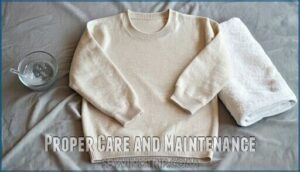This site is supported by our readers. We may earn a commission, at no cost to you, if you purchase through links.

Low-quality cashmere with short fibers pills more than high-quality pieces. Choose cashmere with longer fibers from reputable brands.
Wash gently by hand or use delicate machine cycles with cold water and mild detergent. Turn garments inside out before washing.
Avoid excessive friction from rough surfaces, bags, or belts. Store folded, not hung, in breathable cotton bags. Air dry flat away from direct heat.
When pills appear, use a fabric shaver, sweater stone, or fine-tooth comb to remove them gently. Regular gentle washing actually helps prevent pilling by removing loose fibers before they tangle into pills.
Table Of Contents
- Key Takeaways
- What is Cashmere Pilling?
- Factors That Contribute to Cashmere Pilling
- How to Prevent Cashmere Pilling
- Common Tools for Removing Cashmere Pills
- Alternatives to Cashmere Clothing
- Is Cashmere Pill-Resistant?
- How to Identify Superior Quality Cashmere
- How to Remove Pills From Cashmere Clothes
- Seeking Professional Help for Cashmere Care
- Frequently Asked Questions (FAQs)
- Conclusion
Key Takeaways
- You’ll get pilling regardless of cashmere quality – Even premium Grade A cashmere pills naturally due to friction, so don’t expect any cashmere to be completely pill-resistant
- Choose high-quality cashmere with longer fibers – Look for pieces with 34-42mm fiber length and tight weave density, as they’ll pill less frequently than cheaper options with short fibers
- Wash gently and store properly – Hand-wash inside-out with cold water and mild detergent, then store folded (not hung) in breathable bags to minimize friction damage
- Remove pills promptly with the right tools – Use fabric shavers, sweater stones, or cashmere combs to gently remove pills before they worsen, avoiding scissors or rough handling that can damage fibers
What is Cashmere Pilling?
Every cashmere lover has experienced this frustrating scenario: you’re wearing your favorite sweater, and suddenly those annoying little fuzz balls appear.
Cashmere pilling occurs when delicate cashmere fibers break and tangle together, forming small fuzzy balls on your garment’s surface.
Broken cashmere fibers tangle into fuzzy pills through friction and wear.
The pilling process** starts with fabric friction.
When cashmere rubs against skin, furniture, or other clothing, the fine fibers weaken and snap.
These broken fibers then twist together, creating those unsightly pills you see on sleeves, underarms, and sides.
Understanding pilling causes helps you take control.
Cashmere fiber naturally contains shorter strands that detach easily during wear.
Fiber breakage accelerates in high-friction areas where movement creates constant abrasion.
Lower-quality cashmere pills faster because it contains more short fibers.
While cashmere pilling prevention isn’t foolproof, proper care substantially reduces the problem.
You can’t eliminate pilling entirely, but smart handling keeps your investment looking pristine longer.
Effective pilling prevention methods and cashmere pill removal techniques will restore your garment’s original beauty.
Factors That Contribute to Cashmere Pilling
Understanding what causes cashmere to pill helps you make better purchasing and care decisions. Several key factors determine how quickly your cashmere garments develop those pesky little fuzz balls.
Smart cashmere shopping starts with knowing what makes pills appear faster.
Quality of Cashmere
Cashmere quality directly impacts pilling resistance. Grade A cashmere features longer fibers (34-42mm) and finer diameter (14-16 microns), creating stronger yarn that resists pilling.
Lower grades use shorter, thicker fibers that escape easily, forming pills quickly. Material blends increase pilling tendency compared to 100% cashmere.
Weave density matters—tightly-knit structures prevent fiber movement. Quality cashmere maintains smooth texture longer, making your investment worthwhile.
To determine the quality of your cashmere, check for cashmere quality grades that indicate its durability and performance.
Wear and Tear
Daily use naturally breaks down your cashmere’s delicate structure.
Friction damage occurs when fabric rubs against skin, furniture, or other clothing layers. This constant garment stress leads to fiber breakage in high-wear areas like elbows and underarms.
Fabric abrasion weakens the material, causing loose fibers to tangle into pills.
Following proper cashmere sweater care routines helps prevent cashmere pilling effectively.
Environmental Factors
Your surroundings play a bigger role than you’d think.
Humidity weakens cashmere fibers, making them vulnerable to breakage. Sweat and body oils create moisture damage that leads to abrasion control issues.
Heat accelerates fiber breakage through increased friction. Storage methods matter – poor climate impact from stuffy closets creates the perfect storm for pilling.
Control your environment to protect your investment. Understanding fiber pilling issues is essential to maintaining the quality of your cashmere.
How to Prevent Cashmere Pilling
Preventing cashmere pilling requires smart choices and careful handling from day one. You can substantially reduce pilling by selecting high-quality cashmere, following proper care routines, and storing your garments correctly.
High-Quality Cashmere Selection
Investing in Grade A Cashmere with longer fiber length substantially reduces pilling tendencies.
Premium cashmere features tighter weave density and ideal yarn thickness that withstand daily friction.
Avoid fabric blends that compromise durability—pure cashmere quality tips include checking fiber origins and construction methods.
These cashmere fabric care fundamentals prevent fabric pilling from the start, making your investment worthwhile for years.
Understanding the benefits of pure cashmere is essential for making informed purchasing decisions.
Proper Care and Maintenance
Three simple cashmere care tips reveal fabric longevity.
Hand-wash using cold water and mild detergent designed for delicate fibers.
Turn garments inside-out before cashmere washing to reduce surface friction.
Never wring or twist wet items—gently press water out instead.
Air-dry flat on towels, reshaping while damp.
These pilling prevention methods protect your investment through gentle storage and proper hand maintenance techniques.
For best results, follow cashmere care tips to extend the life of your garments.
Storage Tips
Proper storage prevents friction damage that accelerates pilling. Store cashmere using folded storage methods in breathable garment bags or garment boxes.
Flat laying prevents stretching while breathable bags allow air circulation. Use acid-free tissue between layers for closet organization.
Rotate garments seasonally to distribute wear. These fabric storage techniques protect your investment for decades. Effective fabric storage methods are essential for maintaining the quality of cashmere garments, which is crucial for maintaining the quality and ensuring proper storage.
Common Tools for Removing Cashmere Pills
When pilling does occur on your cashmere garments, you’ll need the right tools to restore their smooth appearance without damaging the delicate fibers.
The most effective de-pilling tools include lint rollers for surface pills, electric fabric shavers for efficient removal, and gentle sweater stones that preserve the fabric’s texture, which are essential for maintaining the cashmere garments’ quality.
Lint Rollers
Lint rollers offer a convenient solution for quick cashmere maintenance.
These handy tools use adhesive sheets to grab surface lint and loose fibers, though they’re less effective on deeply embedded pills.
Here’s what you need to know:
- Roller Types: Choose silicone versions over paper-based options for gentler fabric care
- Adhesive Sheets: Replace frequently to maintain maximum lint removal effectiveness
- Fuzz Prevention: Use light, controlled movements to avoid fiber damage during cashmere maintenance
While lint rollers excel at quick touch-ups, they won’t tackle entrenched pill clusters.
Regular use of lint roller tools can help maintain cashmere garments.
Fabric Shavers
While fabric shavers effectively remove pills from cashmere using rotating blades, proper technique prevents damage.
Choose models with adjustable settings and use the lowest power level for delicate fibers. Apply gentle pressure while moving the shaver in one direction across flat surfaces.
Quality depilling tools protect your investment by safely trimming surface fuzz without harming underlying cashmere structure. These portable lint removers restore garment appearance when used correctly with appropriate fabric shaver tips for ideal fiber protection and cashmere maintenance results.
For superior cashmere care, consider using cashmere shavers to maintain the quality of your garments.
Sweater Stones
Natural pumice sweater stones offer a gentle approach to cashmere care.
These eco-friendly tools contain micro-edges that safely cut pills without damaging delicate fibers.
Simply brush the stone across pilled areas using light pressure and circular motions.
Why sweater stones work perfectly for cashmere:
- Last up to 10 years – making them a cost-effective fabric smoothing solution
- Require no electricity – giving you complete control over pilling removal methods
- Safe for all knits – preventing cashmere pilling while preserving fabric integrity
Stone maintenance is minimal since they naturally sharpen with use.
Popular knitwear brands recommend these cashmere pilling solutions over harsh electric tools.
Alternatives to Cashmere Clothing
If you’re concerned about pilling but love the softness of cashmere, several fabric alternatives offer similar comfort with better durability.
These options include merino wool, alpaca fiber, and high-quality synthetic blends that resist pilling while maintaining warmth and softness.
Pilling-Resistant Fabrics
Excellence in fabric selection eliminates pilling headaches before they start.
Smart shoppers choose materials engineered for durability over beauty alone.
| Fabric Type | Pilling Resistance |
|---|---|
| Merino Wool | Grade 4-5 (Excellent) |
| Pima Cotton | Grade 5 (Superior) |
| TENCEL Lyocell | Grade 4 (Very Good) |
| Anti-pill Fleece | Grade 4 (Very Good) |
| Premium Linen | Grade 5 (Superior) |
Textile innovation delivers remarkable alternatives through advanced fiber technology and weave patterns.
Ring-spun cotton outperforms regular varieties, while fabric blends with engineered synthetics resist wear.
Yarn quality matters—tightly woven, long-staple fibers won’t break down like cheaper options.
These pilling prevention strategies save money long-term.
Synthetic Fiber Options
For those seeking cashmere maintenance tips without the high-maintenance lifestyle, synthetic alternatives deliver impressive results.
Acrylic fibers perfectly mimic cashmere’s softness while offering superior durability. These microfiber options resist pilling through countless wash cycles, making them ideal for busy lifestyles.
Faux cashmere blends combine luxury aesthetics with practical performance. Nylon alternatives provide exceptional stretch and recovery.
Synthetic blends eliminate traditional cashmere clothing care headaches while preventing cashmere damage concerns. You’ll discover these options reduce pilling cashmere worries entirely, offering freedom from delicate handling requirements.
Is Cashmere Pill-Resistant?
Despite investing in premium cashmere, you’ll still face the reality that no cashmere is truly pill-resistant. The delicate nature of cashmere fibers makes them vulnerable to friction and breakage, regardless of price point. Textile science confirms that even Grade A cashmere with superior fiber strength will eventually develop pills through normal wear.
Understanding cashmere durability helps set realistic expectations. While fabric quality affects pilling resistance, it doesn’t eliminate the issue entirely.
Here’s how to maximize your cashmere’s lifespan:
- Choose longer-fiber cashmere for better pilling resistance
- Hand wash gently to prevent cashmere damage
- Use fabric shavers regularly to maintain appearance
- Rest garments between wears to reduce fiber stress
- Store properly folded to minimize friction
Smart cashmere pilling prevention starts with accepting that pills are inevitable, then taking proactive steps to stop cashmere pilling before it becomes problematic. Regular maintenance keeps your investment looking pristine longer. Cashmere’s natural breathable properties also contribute to its overall durability and comfort.
How to Identify Superior Quality Cashmere
While pilling resistance matters, superior cashmere quality makes the biggest difference in your garment’s longevity and appearance. Identifying luxury cashmere starts with understanding what sets Grade A cashmere apart from inferior options.
Here’s how to identify superior cashmere fabric:
- Fiber Length Assessment – Premium cashmere features long fibers (34-40mm) that feel smooth when rubbed between fingers, while shorter fibers create roughness.
- Fabric Density Inspection – Hold the garment up to light; high-quality pieces show consistent, tight weave patterns without thin spots or irregularities.
- Yarn Thickness Evaluation – Superior cashmere uses fine fibers (14-16.5 microns) that create a silky texture, not coarse or scratchy sensations.
- Color Purity Check – White or lightly dyed cashmere typically indicates minimal processing and better fiber integrity than heavily treated darker shades.
Quality cashmere fiber maintains consistent softness throughout the garment. Trust your hands—authentic luxury cashmere feels buttery and lightweight, never rough or overly processed. Understanding proper cashmere dye methods is also essential for maintaining the quality and appearance of the garment.
How to Remove Pills From Cashmere Clothes
Now that you know what makes quality cashmere, let’s tackle those pesky pills that inevitably appear. Removing pills from cashmere clothes isn’t rocket science, but it requires the right approach and tools to preserve your garment’s integrity.
Cashmere Combs work best for gentle pill removal. Hold the fabric taut and comb in one direction using light strokes. Fabric Shavers offer quick results for stubborn pills, but use them sparingly on delicate cashmere. Lint Stones provide a gentler alternative, gliding across the surface to lift away fuzz.
5 Essential Steps for Effective Pill Removal:
- Lay the garment flat on a clean surface with good lighting
- Work in small sections to avoid stretching or damaging fibers
- Move in one direction consistently to prevent creating new pills
- Clean your depilling tools regularly during the process
- Let the garment rest after treatment before wearing or storing
Cashmere maintenance tips include waiting until the fabric is completely dry before attempting pilling removal. Never use scissors or razors, as these can create snags. Regular cashmere pill removal sessions help prevent cashmere pilling from worsening over time.
Seeking Professional Help for Cashmere Care
When home remedies reach their limits, professional cashmere care becomes your best ally.
Cashmere experts possess specialized knowledge about textile preservation that most consumers lack.
Professional cleaning services use gentle solvents and techniques specifically designed for delicate fibers, preventing damage that standard dry cleaners might cause.
Garment specialists offer fabric restoration services that can revive even heavily pilled cashmere.
They’ll assess your piece’s condition and recommend appropriate treatments.
Some provide textile consultation to help you understand proper garment maintenance moving forward.
Professional help becomes particularly valuable for vintage pieces or expensive designer cashmere.
These garment preservation experts can repair holes, reshape stretched areas, and remove stubborn stains while maintaining the fabric’s integrity.
Their specialized tools and experience often achieve results impossible at home, making their services worthwhile for treasured pieces.
Frequently Asked Questions (FAQs)
Do cashmere garments pill?
Yes, cashmere garments naturally pill due to their short, fine fibers that tangle together from friction. This occurs in high-wear areas like underarms and elbows, regardless of quality.
What should you avoid when removing pills from cashmere?
Resist the urge to treat your cashmere like a stubborn weed that needs aggressive removal tactics.
You’ll avoid scissors, razors, or sharp objects that can damage delicate fibers.
Skip rough handling and wait until the garment’s completely dry before depilling.
Will Cashmere stop Pilling?
Cashmere doesn’t completely stop pilling, but it substantially decreases over time.
As you wear and wash your sweater, loose surface fibers gradually shed, leaving behind stronger, longer fibers that pill less frequently.
How do you keep cashmere from Pilling?
Like tending a delicate garden, you’ll prevent cashmere pilling by choosing high-quality pieces, hand-washing gently, resting garments between wears, storing them flat, and using fabric shavers regularly.
Can Cashmere pills be removed?
You can easily remove cashmere pills using specialized tools.
Try a fabric shaver, cashmere comb, or sweater stone to gently lift away those pesky fuzzballs and restore your garment’s smooth texture.
Why does Cashmere pill?
Friction turns cashmere fibers into tiny knots, much like how rope frays when rubbed repeatedly.
Your cashmere pills because its short, delicate fibers break and tangle together when they rub against skin, fabric, or furniture during wear.
How to prevent moths from eating cashmere?
Store your cashmere in airtight containers with cedar blocks or lavender sachets. Clean garments before storage and regularly inspect for moths. Cedar naturally repels these fabric-eating pests.
How to prevent pilling?
Roughly 80% of cashmere naturally pills within the first few wears. Hand-wash inside-out with mild detergent, rest between wears, and store flat. Choose high-quality cashmere with longer fibers for better resistance.
Does pilling mean low quality?
Not necessarily. Pilling doesn’t automatically indicate poor quality cashmere.
Even premium, Grade A cashmere pills naturally due to friction and wear.
However, lower-quality cashmere with shorter fibers does pill more frequently than higher-grade varieties.
How to prevent cashmere from shedding?
To prevent cashmere shedding, choose high-quality pieces with longer fibers, hand-wash gently with mild detergent, store flat in breathable containers, and avoid rough handling or abrasive surfaces.
Conclusion
Protecting your cashmere investment doesn’t have to feel like walking through a minefield.
While cashmere does pill naturally, you’re now armed with proven prevention strategies and removal techniques.
Choose quality pieces with longer fibers, wash gently, and store properly to minimize pilling.
When pills appear, remove them promptly with fabric shavers or sweater stones.
Remember, regular gentle care prevents more damage than aggressive cleaning.
With these methods, your cashmere will maintain its luxurious feel for years.
- https://nori.co/a/blog/how-to-keep-cashmere-from-pilling
- https://thecashmereshop.com/pages/prevent-remove-pilling
- https://www.whiteandwarren.com/blogs/journal/how-to-wash-cashmere-at-home-cleaning-de-pilling
- https://dr-muxue.com/blogs/knowledge/how-to-prevent-and-remove-cashmere-pilling
- https://keepitchic.com/2024/04/16/cashmere-care/















